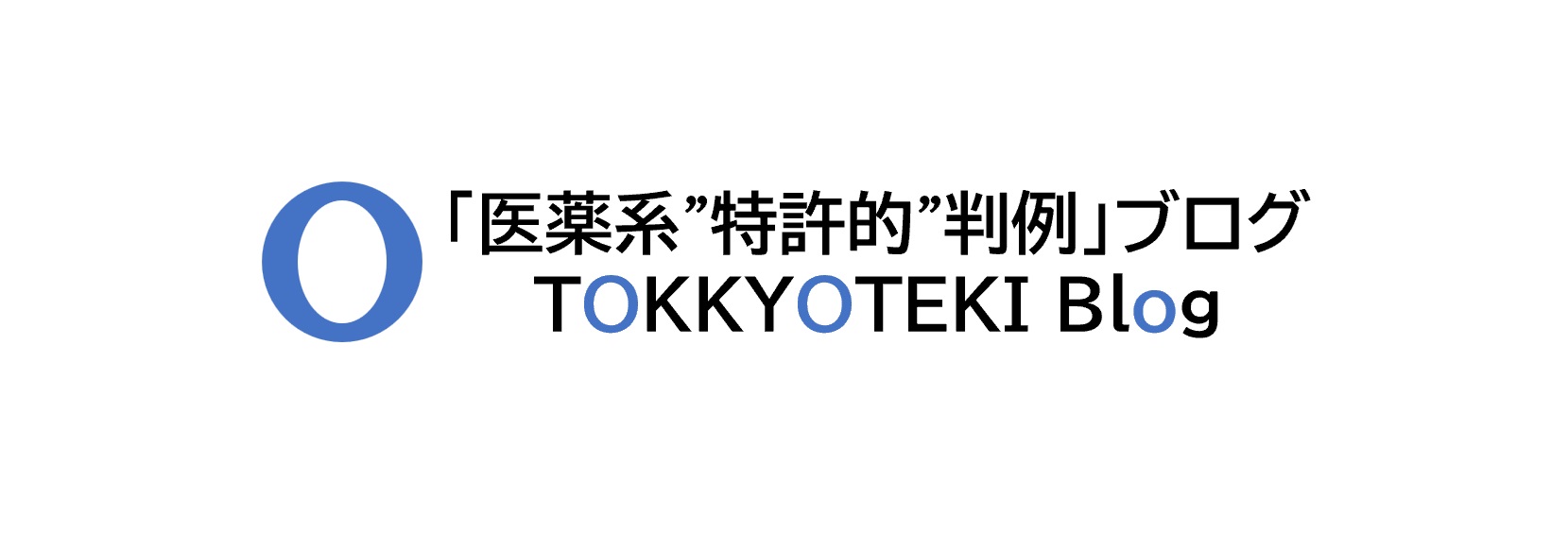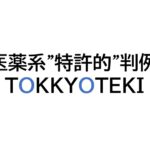抗PCSK9抗体を巡るサノフィ(プラルエントPraluent®)とアムジェン(レパーサRepatha®)の争い: 知財高裁平成31年(ネ)10014
【背景】
「プロタンパク質コンベルターゼスブチリシンケクシン9型(PCSK9)に対する抗原結合タンパク質」に関する特許権(第5705288号及び第5906333号)を保有するアムジェンが、サノフィによるプラルエント® (Praluent®)(被告製品)及びその原薬であるアリロクマブ(Alirocumab)(被告モノクローナル抗体)の生産等が当該特許権を侵害する旨主張して、それら生産等の差止め及び廃棄を求めた事案。
本件発明は、抗体のアミノ酸配列を全く特定せず、PCSK9とLDLR間の結合を遮断して「中和」することとPCSK9との結合に関して本件参照抗体と「競合」することによって発明を特定する機能的に表現されたクレームであり、本件各発明の技術的範囲の属否の他、無効事由の有無(進歩性、実施可能要件、サポート要件)が争点となった。
原判決(2019.01.17 「アムジェン v. サノフィ」 東京地裁平成29年(ワ)16468)は、被告モノクローナル抗体及び被告製品は、本件各発明の技術的範囲にそれぞれ属し、サノフィの主張する無効理由はいずれも理由がないなどとして、サノフィに対し、被告製品及び被告モノクローナル抗体の生産等の差止め並びに被告製品の廃棄を命じたため、サノフィは原判決を不服として控訴を提起していた。
【要旨】
知財高裁も、被告モノクローナル抗体は及び被告製品は、本件各発明の技術的範囲に属し、また、本件各特許は特許無効審判により無効にされるべきものとは認められないものと判断し、サノフィの控訴を棄却した。
以下、本件各発明の技術的範囲の属否についての裁判所の判断の抜粋。本件各明細書記載の具体的なアミノ酸配列を有する抗体に限定されるとのサノフィの主張は認められなかった。
「本件各明細書に開示された技術的思想は,参照抗体1又は2と競合する単離されたモノクローナル抗体が,PCSK9がLDLRに結合するのを妨げる位置及び/又は様式で,PCSK9に結合し,PCSK9とLDLR間の結合を遮断し(中和),対象中のLDLの量を低下させ,対象中の血清コレステロールの低下をもたらす効果を奏するというものである。そして,被告モノクローナル抗体及び被告製品は,上記技術的思想に基づいて解釈された本件各発明の技術的範囲に属することは,前記のとおりである。
本件各発明は,PCSK9とLDLRタンパク質の結合を中和し,本件各参照抗体と競合する,単離されたモノクローナル抗体を提供するものであり,PCSK9とLDLR間の結合を遮断して「中和」すること(構成要件1A,2A)と,PCSK9との結合に関して参照抗体と「競合」すること(構成要件1B,2B)の双方を構成要件としている。そして,本件各明細書には,本件各発明が,参照抗体1又は2と競合する機能のみによって発明を特定するものであることをうかがわせる記載があるとはいえず,そのことを前提に実施例に限定されるとする控訴人の主張は採用できない。
また,本件各発明は,アミノ酸配列によって特定されるものではないから,本件各明細書記載の具体的な抗体又は当該抗体に対して特定の位置のアミノ酸の1若しくは数個のアミノ酸が置換されたアミノ酸配列を有する抗体に限られると解すべき理由はない。
さらに,本件各明細書には,免疫プログラムの手順及びスケジュールに従った免疫化マウスの作製,免疫化マウスを使用したハイブリドーマの作製,参照抗体1又は2と競合するPCSK9-LDLRとの結合を強く遮断する抗体を同定するためのスクリーニング及びエピトープビニングアッセイの方法が記載され,これらの記載に基づき,一連の手順を繰り返し行うことによって,本件各明細書に具体的に記載された参照抗体と競合する中和抗体以外にも,参照抗体1又は2と競合する中和抗体を得ることができること,上記エピトープビニングアッセイの結果確認された,15個の本件発明1の具体的抗体,7個の本件発明2の具体的抗体が得られることに加えて,上記2441の安定なハイブリドーマから得られる残りの抗体についても,同様のエピトープビニングアッセイを行えば,参照抗体1又は2と競合する中和抗体を得られるものと認識できることは,後記3,4のとおりである。
そうすると,本件各明細書の記載から当業者が実施可能な範囲が,本件各明細書記載の具体的な抗体又は当該抗体に対して特定の位置のアミノ酸の1若しくは数個のアミノ酸が置換されたアミノ酸配列を有する抗体に限られるとはいえず,控訴人の主張は,この点においても採用することができない。」
以下、差止請求の当否についての裁判所の判断の抜粋。サノフィは、プラルエント® (被告製品)の差止めが患者利益を害することを具体的に立証できず、裁判所は差止請求は権利濫用に当たらないと判断した。
「控訴人は,被告製品及び被告モノクローナル抗体の生産・譲渡等を差し止めることは,現在及び将来被告製品の投与を受ける患者に重大な健康上の不利益や将来の治療上の不安をもたらすから,被控訴人による差止請求は,権利濫用に当たり,許されない旨主張し,B作成の意見書(乙33)を提出する。
しかしながら,乙33は,被告製品の譲渡等が差し止められることにより,患者にとっての選択肢が減り,被告製品を使用している患者の困惑が予想されるなどの問題点を指摘するものの,被告製品に代えて被控訴人が製造販売している製品を使用することにより,具体的に患者の健康上の不利益等が生じることまで指摘するものではないから,被告製品の使用を差し止めることにより,公共の利益が損なわれるとの具体的な事実が立証されているとはいえない。
そして,医薬品の分野においては,公共の利益の観点から差止請求権を制限すべき場合もあり得ると解されるものの,具体的な事実を立証することなく,単に患者にとって選択可能なオプションが存在する方が望ましいとの理由により,侵害品の生産,譲渡等の差止請求が許されないと解することはできない。よって,控訴人の主張は採用できない。」
【コメント】
アムジェンが保有する本件特許(第5705288号及び第5906333号)についてサノフィが提訴した無効審判請求不成立審決取消訴訟の知財高裁判決が昨年末に出されている。これら審決取消訴訟において、知財高裁は、いずれも容易想到性を否定し進歩性を認め並びにサポート要件及び実施可能要件にも適合するとした本件審決の判断に誤りはないとして、サノフィ主張の取消事由はいずれも理由がないと判断していた(サノフィ敗訴)。これら審決取消訴訟判決に対してサノフィは上告受理申立てをしている。
このようなクレーム(例えば、スリムに一般化すれば、参照物Xと競合する、タンパク質Y阻害剤。以下、参照物競合型機能的表現クレームという)は、権利化する側として非常に魅力的で興味深いものであるが、逆に他社に特許を取られてしまうと非常に厄介なものである。今回の判決を受けて、例えば、タンパク質阻害剤X(参照物)を得た者が参照物競合型機能的表現クレームでの特許権を得ようとするだろう。さらに、タンパク質阻害剤X1、X2、X3といくつもの阻害剤を参照物とした参照物競合型機能的表現クレームの特許権が乱立する虞があるのではないか。そうなると、被疑侵害者側(侵害クリアランス/FTO調査)にとって、属否判断の際にいちいち参照物を得て自社品との競合試験等の機能確認が必要となり、すなわち、侵害予見可能性が著しく低く困難とならざるをえないことになる。個人的には、これら知財高裁の判断が産業の発展に寄与するものといえるのか懸念している。
特許第5705288号及び特許第5906333号の欧米ファミリー特許の状況をみても、AmgenとSanofiとの抗PCSK9抗体を巡る争いは激しさを増している。
- EP2215124B1:
Claim 1. A monoclonal antibody or fragment thereof that binds to human PCSK9 and is neutralizing in that an excess of said antibody or fragment thereof is capable of reducing the quantity of PCSK9 bound to LDLR in an in vitro competitive binding assay, wherein said monoclonal antibody or fragment thereof competes for binding to PCSK9 with
(a) an antibody comprising a heavy chain variable region of the amino acid sequence in SEQ ID NO: 49; and a light chain variable region of the amino acid sequence in SEO ID NO: 23; or
(b) an antibody comprising a heavy chain variable region of the amino acid sequence in SEQ ID NO: 67; and a light chain variable region of the amino acid sequence in SEQ ID NO: 12.Sanofiらが異議申立てを行ったが、EPOは、特許権者AmgenによるAuxiliary Request 2はEPC要件を満たすとして補正を認め特許維持を決定した。この決定に対してSanofiらは審判請求し、現在審理中(Appeal No. T0845/19-3.3.04)。2020年3月24日に口頭審理が予定されている。
ドイツでは、SanofiがAmgen特許を侵害しているとの判断がされ、Sanofiは控訴したとのことである(Amgen press release 2019.07.11 Amgen Comments on PCSK9 Patent Litigation in Germany; Sanofi press release 2019.07.19 Statement Regarding Düsseldorf Regional Court Decision in Ongoing Praluent® (alirocumab) Patent Litigation in Germany)。
- US8,829,165:
Claim 1. An isolated monoclonal antibody, wherein, when bound to PCSK9, the monoclonal antibody binds to at least one of the following residues: S153, I154, P155, R194, D238, A239, I369, S372, D374, C375, T377, C378, F379, V380, or S381 of SEQ ID NO:3, and wherein the monoclonal antibody blocks binding of PCSK9 to LDLR.
米国におけるSanofiのPraluent®(Alirocumab)に対する特許侵害訴訟(Amgen v. Sanofi Docket No. 1:14-cv-01317; 2014.10.17 filed)の対象特許。2017年1月10日、デラウエア州連邦地裁は特許有効でありSanofiのPraluent®販売に対する差止めを認めたため、SanofiはCAFCに控訴した(No.17-1480)。2017年10月5日、CAFCは、恒久的な差止命令を取消し、地裁に差し戻す判決をして、地裁で再審理され、2019年8月28日、Amgen特許は実施可能要件を満たさず無効との判決が出された(Sanofi press release August 28 2019: Sanofi : U.S. District Court invalidates Amgen patent claims targeting PCSK9)。
この特許は、AmgenのREPATHA®の有効成分であるevolocumabを保護する特許でもある。2016年10月22日、REPATHA®(evolocumab)承認に基づく特許期間延長出願が提出された。同時にUS8,030,457及びUS8,981,064についても同日に延長出願がされている。これは、US8,829,165がSanofiのPraluent®(Alirocumab)に対する特許侵害訴訟に係属しており、その行く末によってどの特許でREPATHA®(evolocumab)の期間延長を得るか(※日本と違い米国の特許期間延長制度は有効成分につき一つの特許しか延長を認めない)選択肢を残しておくためである(2017.07.17 USPTOへの審査提出書類より)。訴訟決着まで延長出願審査を待つようAmgenによる請願を認めUSPTOは延長出願の審査を停止している。
- US8,030,457:
Claim 1. An isolated neutralizing antigen binding protein that binds to a PCSK9 protein comprising the amino acid sequence of SEQ ID NO: 1, wherein the neutralizing antigen binding protein comprises: a heavy chain polypeptide comprising the following complementarity determining regions (CDRs): a heavy chain CDR1 that is a CDR1 in SEQ ID NO: 49; a heavy chain CDR2 that is a CDR2 in SEQ ID NO: 49; a heavy chain CDR3 that is a CDR3 in SEQ ID NO: 49 and a light chain polypeptide comprising the following CDRs: a light chain CDR1 that is a CDR1 in SEQ ID NO: 23; a light chain CDR2 that a CDR2 in SEQ ID NO: 23; and a light chain CDR3 that is a CDR3 in SEQ ID NO: 23.
AmgenのREPATHA®の有効成分であるevolocumabを保護する特許である。US8,829,165と同様に、2016年10月22日、REPATHA®(evolocumab)承認に基づく特許期間延長出願が提出されたが、USPTOはその審査を停止している。
- US8,981,064:
Claim 1. A monoclonal antibody that binds to human PCSK9 at an epitope on PCSK9 that overlaps with an epitope that is bound by an antibody that comprises: a heavy chain variable region of the amino acid sequence in SEQ ID NO: 49; and a light chain variable region of the amino acid sequence in SEQ ID NO: 23, and wherein the epitope of said monoclonal antibody further overlaps with a site to which an EGFa domain of LDLR binds and thereby blocks binding between human PCSK9 and the EGFa domain of LDLR.
AmgenのREPATHA®の有効成分であるevolocumabを保護する特許である。US8,829,165と同様に、2016年10月22日、REPATHA®(evolocumab)承認に基づく特許期間延長出願が提出されたが、USPTOはその審査を停止している。
- US8,563,698:
Claim 1. An isolated monoclonal antibody, wherein, when bound to PCSK9, said monoclonal antibody binds to at least one residue within the sequence set forth by residues 123-132 of SEQ ID NO: 1, and wherein said monoclonal antibody reduces binding between PCSK9 and an EGFa domain of LDLR protein antagonizes PCSK9’s inhibition of cellular LDL uptake.
SanofiのPraluent®(Alirocumab)に対する特許侵害訴訟(Amgen v. Sanofi Docket No. 1:14-cv-01317; 2014.10.17 filed)の対象特許。
- US8,859,741:
Claim 1. An isolated monoclonal antibody that binds to PCSK9, wherein the isolated monoclonal antibody binds an epitope on PCSK9 comprising at least one of residues 237 or 238 of SEQ ID NO: 3, and wherein the monoclonal antibody blocks binding of PCSK9 to LDLR.
SanofiのPraluent®(Alirocumab)に対する特許侵害訴訟(Amgen v. Sanofi Docket No. 1:14-cv-01317; 2014.10.17 filed)の対象特許。
- US8,871,913:
Claim 1. An isolated monoclonal antibody that binds to an epitope of PCSK9, wherein the epitope includes at least one of amino acid residues 311 to 313 of SEQ ID NO: 1, and wherein the monoclonal antibody blocks binding of PCSK9 to LDLR.
SanofiのPraluent®(Alirocumab)に対する特許侵害訴訟(Amgen v. Sanofi Docket No. 1:14-cv-01349; 2014.10.28 filed)の対象特許。
- US8,871,914:
Claim 1. An isolated human monoclonal antibody that binds to an epitope on PSCK9, wherein the epitope comprises at least one of amino acid residues S123, E129, A311, D313, or D337 of SEQ ID NO: 1, and wherein the monoclonal antibody blocks binding of PCSK9 to LDLR.
SanofiのPraluent®(Alirocumab)に対する特許侵害訴訟(Amgen v. Sanofi Docket No. 1:14-cv-01349; 2014.10.28 filed)の対象特許。
- US8,889,834:
Claim 1. An isolated monoclonal antibody that binds to an epitope of PCSK9 that comprises at least three of amino acid residues 207, 208, 162, 164, 167, 132, 351, 390, 413, 123, 129, 311, 313, or 337 of SEQ ID NO:1, and wherein the monoclonal antibody blocks binding of PCSK9 to LDLR.
SanofiのPraluent®(Alirocumab)に対する特許侵害訴訟(Amgen v. Sanofi Docket No. 1:14-cv-01414; 2014.11.17 filed)の対象特許。
- US9,920,134:
Claim 1. A monoclonal antibody that binds to a PCSK9 protein, wherein the PCSK9 protein comprises the amino acid sequence of SEQ ID NO: 1, wherein the monoclonal antibody comprises a light chain complementarity determining region (CDR) CDR1 that is a CDR1 in SEQ ID NO:46; a light chain CDR2 that is a CDR2 in SEQ ID NO:46; and a light chain CDR3 that is a CDR3 in SEQ ID NO: 46, and wherein the monoclonal antibody comprises a heavy chain CDR1 that is a CDR1 in SEQ ID NO:60; a light chain CDR2 that is a CDR2 in SEQ ID NO:60; and a light chain CDR3 that is a CDR3 in SEQ ID NO:60.
- US9,045,547:
Claim 1. A method for treating hypercholesterolemia in a patient, said method comprising administering to a patient in need thereof a therapeutically effective amount of a monoclonal antibody that binds to PCSK9, wherein the monoclonal antibody binds to an epitope on PCSK9 comprising at least one of the following residues: S153, I154, P155, R194, D238, A239, I369, S372, D374, C375, T377, F379, V380, or S381 of SEQ ID NO: 3, and wherein the monoclonal antibody blocks binding between PCSK9 and an EGFa domain of LDLR to thereby reduce an elevated serum cholesterol level.
- US8,168,762:
Claim 1. An isolated neutralizing antigen binding protein that binds to a PCSK9 protein comprising the amino acid sequence of SEQ ID NO: 1, wherein the neutralizing antigen binding protein comprises: a heavy chain polypeptide comprising the following complementarity determining regions (CDRs): a heavy chain CDR1 that is a CDR1 in SEQ ID NO: 67; a heavy chain CDR2 that is a CDR2 in SEQ ID NO: 67; a heavy chain CDR3 that is a CDR3 in SEQ ID NO: 67; and a light chain polypeptide comprising the following CDRs: a light chain CDR1 that is a CDR1 in SEQ ID NO: 12; a light chain CDR2 that a CDR2 in SEQ ID NO: 12; and a light chain CDR3 that is a CDR3 in SEQ ID NO: 12.
- US8,883,983:
Claim 1. An isolated monoclonal antibody that binds an epitope on hPCSK9 comprising one or more of residues 207, 208, 162, 164, 167, 132, 351, 390, 413, 123, 129, 311, 313, or 337 of SEQ ID NO:1, and wherein the monoclonal antibody blocks binding of PCSK9 to LDLR.
- US9,056,915:
Claim 1. A monoclonal antibody that binds to an epitope on PCSK9, wherein the epitope comprises at least one of the following residues: S153, I154, P155, R194, D238, A239, I369, S372, D374, C375, T377, C378, F379, V380, or S381 of SEQ ID NO:3, and wherein said monoclonal antibody comprises: a heavy chain variable region; and a light chain variable region; wherein the monoclonal antibody blocks binding interaction between PCSK9 and EGFa domain of LDLR.
- US9,493,576:
Claim 1. A monoclonal antibody that recognizes a conformational epitope on human PCSK9 comprising amino acid residues: S153, R194, D238, D374, T377, and F379 of SEQ ID NO: 3, wherein the monoclonal antibody reduces binding between PCSK9 and EGFa domain of LDLR.



コメント
【追記】AMGEN INC. v. SANOFI (Fed. Cir. 2021) 2020-1074: Decided February 11, 2021
“Amgen Inc., Amgen Manufacturing, Ltd., and Amgen USA, Inc. (collectively, “Amgen”) appeal from a decision of the United States District Court for the District of Delaware granting Judgment as a Matter of Law (“JMOL”) of lack of enablement of claims 19 and 29 of U.S. Patent 8,829,165 (the “’165 patent”) and claim 7 of U.S. Patent 8,859,741 (the “’741 patent”). See Amgen Inc. v. Sanofi, No. CV 14-1317-RGA, 2019 WL 4058927, at *1–2, *13 (D. Del. Aug. 28, 2019) (“Decision”).
・・・
We have considered Amgen’s remaining arguments but find them unpersuasive. For the reasons above, we affirm the district court’s determination that the asserted claims are invalid for lack of enablement.”
http://www.cafc.uscourts.gov/sites/default/files/opinions-orders/20-1074.OPINION.2-11-2021_1731739.pdf